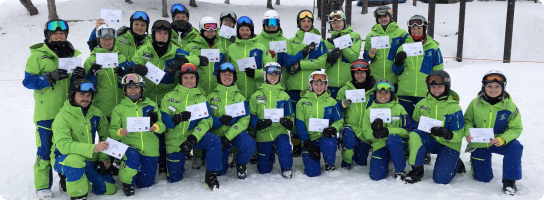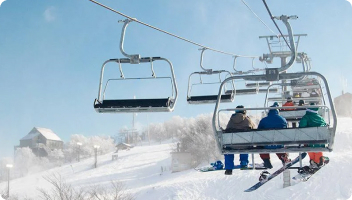Work A Ski Season at Cerro Cathedral
Discover information on working a ski season at Cerro Cathedral and browse winter jobs.

Meaning ‘Mount Cathedral’ in Spanish, due to the resemblance of the landscape with medieval summits, and set around a stunning, large lake, Cerro Catedral and its nearby town, Bariloche, are pretty much postcard perfect. It is one of the most popular holiday spots for Argentines and Brazilians. By South American standards, it is one of the most developed resorts. The season usually runs from mid-June to early October and jobs start in early June.
Cerro Catedral is located on the western side of Argentina, near the border with Chile, in the southern end of the Andes mountain range. The town of Bariloche is a 15-20 minute drive or bus trip from the ski area of Cerro Catedral.
Getting There
To get there, it is highly recommended to fly into Bariloche itself, with Santiago airport in Chile or Buenas Aires in Argentina being the likeliest transfers. While taking the bus to Bariloche may be cheaper, some journeys, if not properly researched, may take up to 20 hours due to windy, mountainous roads – you have been warned.
Avoid if Possible
In late July and early August you will come across the school crowd – the equivalent of Spring Break / Schoolies in Bariloche. You will encounter large groups of students wearing identical hostel branded ski gear who wander aimlessly on the slopes and clog up the lift lines and flood the restaurants. This is the time to check out other parts of Argentina.
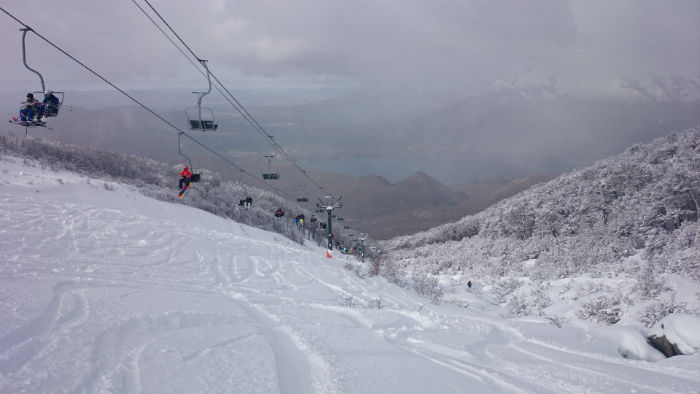
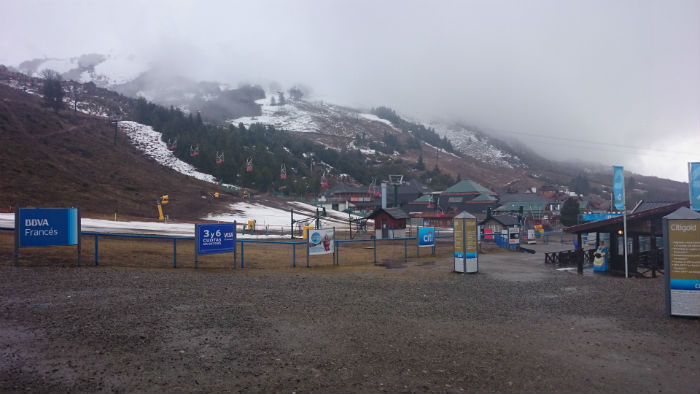
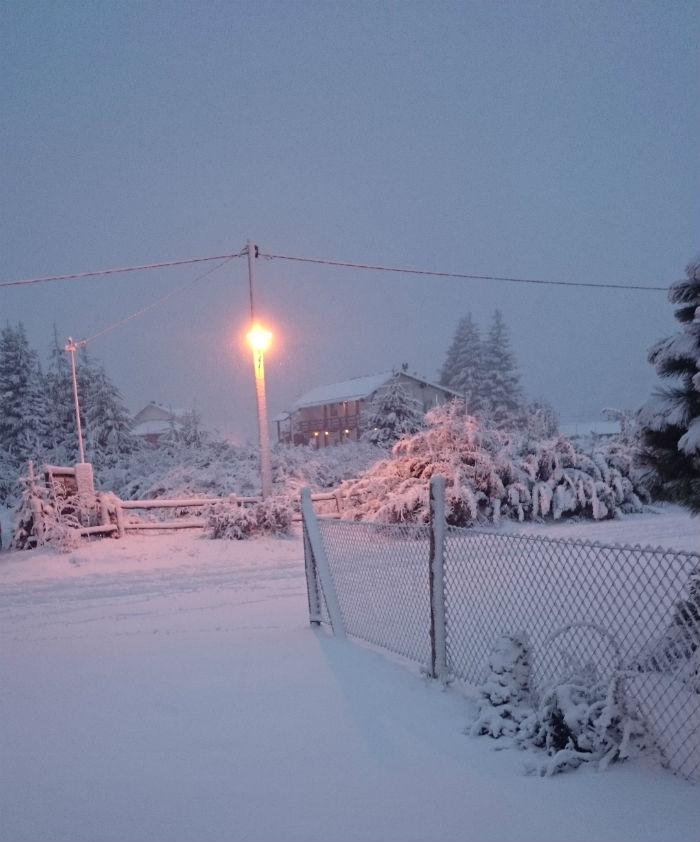
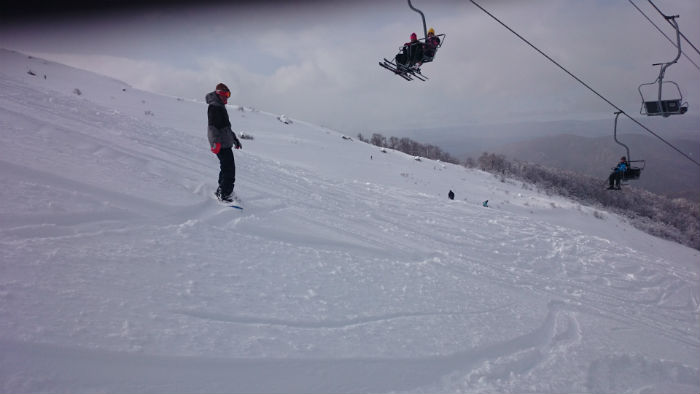
How is the Mountain at Cerro Catedral?
The ski-able area is impressive, but lifts are can be randomly closed due to prevailing winds. In terms of terrain, the mountain has a lot of offer, for all levels, but probably suits intermediates with a bit of good advanced terrain. There are 1200 hectares (2,965 acres) of ski-able terrain in total and over 120km of on-piste runs accessed by 39 lifts. The lifts are pretty modern by Argentine standards and include high-speed lifts which is unusual for South America.
It’s worth noting, if you are first on the lift, that you will get a high number of runs as the lifts typically are not busy until 10am. As one of the most popular resorts in Argentina, the lifts can be pretty hectic at peak times, particularly in July.
Cerro Catedral is a particularly low mountain. The base is just 1030 meters (3379 ft) and the summit is 2100m (6889 ft). This means that the snow can be quite patchy at Cerro Catedral, particularly near the base. Late in the season it can rain, meaning that lower parts of the mountain may be closed. If that happens, the lifts will take you up top where you can ride above the rain line. There are a few good tree runs lower down on the mountain if the snow holds up. Average snowfall at the top of the mountain is 6 metres (236 inches).
Those keen can hike the peak with reasonable ease and much of the good terrain is off-piste. Backcountry is possible, but you will need appropriate gear and it can be difficult to do safely due to weather which can rapidly change and because it sometimes rains at Cerro Catedral.
On the whole, the mountain is good for working a Southern Hemisphere winter and better than most resorts in Australia or New Zealand, but not even a dint on other resorts like Niseko, Japan.
Mountain Stats
- On piste ski-able terrain: 120 kilometers of trails
- Total ski-able terrain: 1200 hectares
- 39 lifts
- Base Height : 1030 m
- Summit Height : 2100 m
- Vertical Drop: 1070 m
- Longest run: 9 miles
- Average maximum snowfall during the season: (Summit 2100m – 6 metres) – (Mid-Station 1600m 3 metres) – (Base 1030m – 1.5 metres )
- Winter temperature average low: – 2 ° Celsius
- Winter temperate average high: 12 ° Celsius
Getting a Visa to Argentina
Working Holiday Visas
Argentina has working holiday visas for a number of countries to allow you to work in the country over a winter season, including for Australians and New Zealanders. See Argentina – Guide to Working at a Ski Resort for information on getting a working holiday visa to Argentina.
Tourist Visa
If you are not working, you can get a tourist visa to stay for up to 90 days.
There are a large number of countries that do not require a visa if travelling up to 90 days. The list is here https://cnyor.cancilleria.gob.ar/en/countries-list-do-not-require-tourist-visa-when-visiting-argentina
If your country is not on the list, you will need to apply for a tourist visa. Information on tourist visas is available at http://cnyor.mrecic.gov.ar/en/node/1817
Bariloche Town Vibe
The main town is set in the foothills of the Andes and on the southern shore of the Nahuel Huapi Lake and has a permanent population of around 100,000. It caters to summer and winter activites. It is around 15 – 20 minutes to the ski area from the town.
Bariloche is a huge tourist trap and is quite expensive. While it has everything you would need, these are at prices that would deter most travellers from impulse purchases. However, it is cheaper than resorts in Chile and other resorts in Argentina such as Las Lenas.
Be warned, siesta can be a real irritant for the unprepared. Most shops and some restaurants will be shut from 12noon and up to 4:30pm, though they will re-open and remain so until 8-9pm.
The night life in the town of Bariloche is typical of Argentina, where most people will eat dinner between 9pm to 11:00pm and then head out afterwards. Bars and pubs will slowly fill until around 1am. This means that the clubs are fairly empty until 2am – 3am, so be prepared for a long haul if you are making a night of it.
The exception to this is the on-mountain bars which have a surge as people finish their runs around 5pm and then will die around 8pm as the last buses leave back for the town. On mountain there are also a couple of bars which alternate for big nights during peak season. In fact, Cerro Catedral is rare in South America in having an on-mountain village at the base of the mountain.
Bariloche Town Services and Getting Money
Money
There are a number of banks in town, which will not provide services to 99.9% of tourists.
You will need to rely on the ATMs for cash. These provide services in most languages but, from time to time, they will reject a foreign card and, annoyingly, are often out of cash. Many of these ATMs will be closed during siesta for reasons unknown – it seems machines need to sleep too in Argentina.
Be aware that there are dozens of unofficial, tracksuit-wearing currency changers on the street who offer a substantially better exchange rate than the official rate at banks and ATMs. They will offer to change US dollar bills into Argentinean pesos. US$100 denomination bills will get you a better rate than lower denominations.
Typically the street urchins cannot change more than $US200-$US300 at a time. Be very careful if you’re trying to swap big numbers as you will get a lot of attention and you are likely to be recognized later. The street urchins are in semi-competition with each other and will try to bargain with you.
Be aware that this ‘blue’ market is illegal, even though it is a part of daily life in Argentina at the moment. Be aware also that there is a high chance that you will get counterfeit Argentinean pesos in return – the real Argentine currency has a number of security measures you can verify very quickly. Beware also of the usual shenanigans: sleight of hand, pick pockets, receiving knife wounds, miscounts, etc.
See also an article in The Guardian on this street currency exchange
Shopping
There is one large supermarket in Bariloche and several smaller ones. If you are buying food from restaurants, stay clear of the main drag, there are better and less expensive places throughout the town.
Do not look to purchase ski gear in town. Whilst there are top quality boutiques including North Face, Mountain Hardware, Columbia, Spyder and other brands, the shops on the mountain are cheaper options. That said, the price of gear in Argentina is between 2 and 4 times more expensive what you would pay for the same item in USD on Amazon.com.
Finding Accommodation
Staying on mountain at the Bariloche ski area is possible but the accommodation is more expensive and there is not too much to do when you are not carving the hill. A much better option is to find a place in the main town.
The best hostel is the Penthouse Hostel in Bariloche Township. It’s clean, awesomely located and has a superb view over the city and the lake.
Other options include housing rental, hotels and hostels. Avoid anywhere which offers the student packages.
Finding Work
Most of the staff on mountain were Latin American. As a very large number Brazilian tourists frequent the mountain, practically all of the speak Spanish and Portuguese and a little English.
As with most resorts in South America, finding work is extremely difficult for foreigners at Cerro Catedral. The resort just does not have a culture of hiring foreign seasonal workers unlike resorts in Australia, NZ, North America and Europe. It is often a better call to simply save up an extra bit of money and just ride for a few weeks / months until the money runs out.
With the economy in pretty bad shape, finding a cash job in town at a restaurant, bar or shop is also pretty difficult and the wages are very low. Picking up glasses at a bar or restaurant in the centre of town would be the best shot if you are determined but you may be poorly treated and you risk deportation if you are caught.
Your best bet to work for the mountain is ski instructing if you already have your instruction certificate. To work with the mountain you will probably need to speak Spanish as most of the customers are Spanish speaking, although there is a very small demand for English speakers.
To apply for work with the mountain go to www.catedralaltapatagonia.com and send your CV to [email protected]. It is likely that you will already need to have arranged your working holiday visa. Another option is to arrive before the season starts and approach the ski school directly – this will give you a better chance of securing employment as they will be able to put a face to your application.
Final Tips
Getting a season pass will often be cheaper than getting the individual day passes even if you are only there for a short while.
Latest Cerro Catedral Job Postings
There are currently no jobs listed for this job type.


